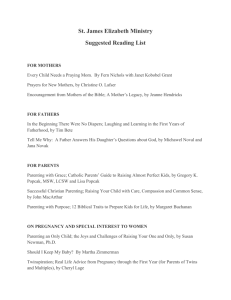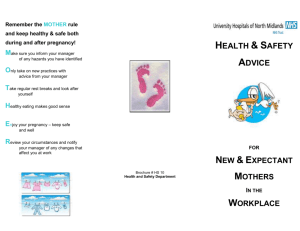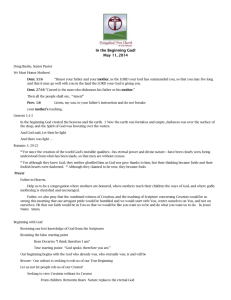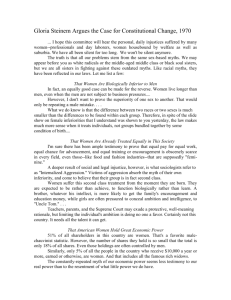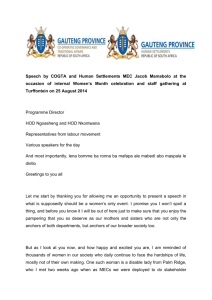College of Health and Sciences - Notre Dame of Marbel University
advertisement
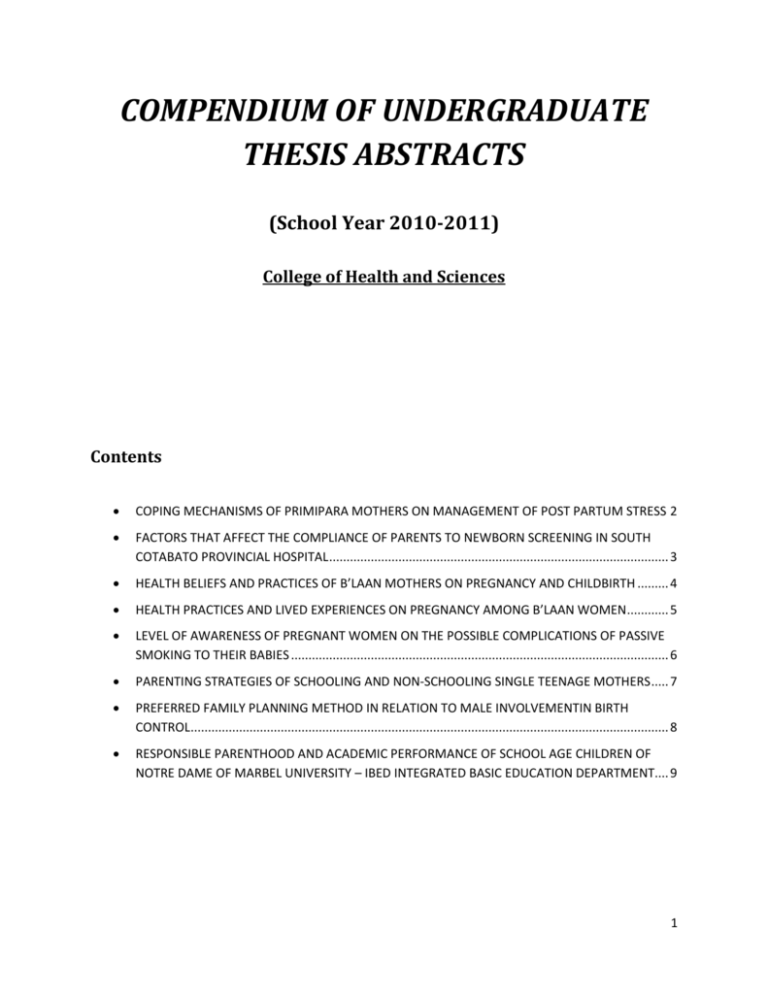
COMPENDIUM OF UNDERGRADUATE THESIS ABSTRACTS (School Year 2010-2011) College of Health and Sciences Contents COPING MECHANISMS OF PRIMIPARA MOTHERS ON MANAGEMENT OF POST PARTUM STRESS 2 FACTORS THAT AFFECT THE COMPLIANCE OF PARENTS TO NEWBORN SCREENING IN SOUTH COTABATO PROVINCIAL HOSPITAL .................................................................................................. 3 HEALTH BELIEFS AND PRACTICES OF B’LAAN MOTHERS ON PREGNANCY AND CHILDBIRTH ......... 4 HEALTH PRACTICES AND LIVED EXPERIENCES ON PREGNANCY AMONG B’LAAN WOMEN ............ 5 LEVEL OF AWARENESS OF PREGNANT WOMEN ON THE POSSIBLE COMPLICATIONS OF PASSIVE SMOKING TO THEIR BABIES ............................................................................................................. 6 PARENTING STRATEGIES OF SCHOOLING AND NON-SCHOOLING SINGLE TEENAGE MOTHERS ..... 7 PREFERRED FAMILY PLANNING METHOD IN RELATION TO MALE INVOLVEMENTIN BIRTH CONTROL.......................................................................................................................................... 8 RESPONSIBLE PARENTHOOD AND ACADEMIC PERFORMANCE OF SCHOOL AGE CHILDREN OF NOTRE DAME OF MARBEL UNIVERSITY – IBED INTEGRATED BASIC EDUCATION DEPARTMENT.... 9 1 COPING MECHANISMS OF PRIMIPARA MOTHERS ON MANAGEMENT OF POST PARTUM STRESS (Michell Jane B. Cagurol; Noel Alvaro S. Ilagan; Rhea Jean S. Navarro; & Chessa B. Serocefino, 2011) Abstract This study aimed to identify the coping mechanisms used by the primipara mothers in managing the post partum stress in terms of: age, civil status, educational attainment, and economic status. Considering the focus of the study, the investigators applied the purposive sampling technique in the determination of primipara mothers as participants of the study. The participants were asked to answer the survey instrument and were interviewed in order to support their answers. The data were processed and presented in tabulator form. The t-test and Analysis of Variance (ANOVA) were utilized in testing the relationship of the independent variable (coping mechanism) and dependent variables (age, civil status, educational attainment, and economic status).Based on the results, majority of the primipara mothers use the ‘post- traumatic growth’ as coping mechanism in managing post partum stress. The least applied coping mechanism is ‘identification.’ Moreover, the coping mechanism of primipara mothers is not influenced by and has no significant relationship with age, status, educational attainment, and economic status of the primipara motherparticipants.The investigators recommend the following: conduct another study to support the findings of the present study; apply longitudinal survey to determine the stability over the time test; and utilization of a systematic sampling technique in order to come up with a more reliable data. 2 FACTORS THAT AFFECT THE COMPLIANCE OF PARENTS TO NEWBORN SCREENING IN SOUTH COTABATO PROVINCIAL HOSPITAL (Nesa Thea O. Movilla; May Florence B. Abu; & Joey Anne M. Bismar, 2011) Abstract This study is designed to find out the factors that affect the compliance of parents to Newborn Screening (NBS) in South Cotabato Provincial Hospital. Descriptive research design was used in assessing the demographic profile of the parents such as: age; economic status and educational attainment, who gave birth such at South Cotabato Provincial Hospital. The data were gathered through series of surveys done and the record of those who complied to NBS at the Newborn Screening Office of the said hospital. All post-partum patients who gave birth from August 1-31, 2010 were involved in the study. The total population of the participants was 145. There were 84 mothers and 61 fathers. The study revealed that most of the mothers who gave birth in South Cotabato Provincial Hospital were young adults garnering 49 or 58.33 percent of the population of mothers. There were 23 or 27.38 percent adolescent mothers and there were 12 or 14.28 percent middle adult mothers. On the other hand, most of the fathers were young adults garnering of 36 or 59.01 percent of the population of fathers followed by middle adult fathers which acquired 20 or 32.80 percent and lastly adolescent fathers which were 5 of 8.20 percent. In terms of the parents’ economic status, 116 or 80 percent of the total population are poor and 29 or 20 percent belong to the lower class status. In terms of Educational attainment, much of the mothers reached the high school level which acquired 44 or 52.38 percent of the population of mother, followed by mothers who reached the college level at the population of 30 or 35.71 percent of the total population. The least number belong to the elementary level mothers who gained 10 or 11.90 percent. In terms of the fathers’ educational attainment, high school fathers earned the highest at 35 or 57.37 percent. This result is followed by fathers who reached the college level who garnered 15 or 24.59 percent. The least number are fathers who reached the elementary level with population of 11 or 18.03 percent. 3 HEALTH BELIEFS AND PRACTICES OF B’LAAN MOTHERS ON PREGNANCY AND CHILDBIRTH (Rezsen Christopher A. Sampang; Emme Grace C. Borja; Xyza L. Melegrito; & Nikko S; Hibaler, 2011) Abstract The study aimed to determine the health beliefs and practices of B’laan mothers and its effects on pregnancy and childbirth. The study is descriptive in nature which provides information about their group, their customs, norms, beliefs and traditions passed from one generation to generation. The locale of the study is Bo. 7 Koronadal City, South Cotabato. The respondents of the study were the female B’laan residents of Bo. 7, Koronadal City, South Cotabato. They were randomly selected from the entire population of the locale. Data were gathered from the respondents through interview and were categorized as desirable and undesirable based on the effects on the health concepts of the respondents. Results show that the undesirable health beliefs and practices were being performed by the respondents. Thus, the researchers conclude that the respondents are highly at risk in terms of the following complications: respiratory diseases, neonatal sepsis, infection, meconium aspiration syndrome, abnormalities and deformities in newborn, fetal distress, neonatal tetanus, hemorrhage, fetal death and maternal death. Such traditional ways or culture factors may contribute in the increase of morbidity and mortality rate among B’laan mothers and children. 4 HEALTH PRACTICES AND LIVED EXPERIENCES ON PREGNANCY AMONG B’LAAN WOMEN (Ma. Ronelyn S. Matulac; Franz Karyl M. Rufino; Cheysserr B. Bayan; & Cherry C. Gestupa, 2011) Abstract This study is intended to determine the various health practices and lived experiences on pregnancy among B’laan women. The design used in this study is phonological qualitative research design. It is applicable since it is used to gain insight into people’s attitudes, behaviors, value systems, concern, motivations, aspirations, culture or lifestyles. The participants of this research are the women of Sitio Upper Acub, San Isidro, who had experienced pregnancy. The investigators prefer this sampling technique because it is fast, inexpensive and easy. The women had been chosen regardless of their age as long as they had been pregnant or presently pregnant. With the data gathered, the results revealed that B’laan women of Sitio Acub are still performing their traditional practices on pregnancy. However, it was noted that despite the traditional practices on pregnancy handed down on them by their elders, the B’laan women of Sitio Acub are also observing some modern ways of safe pregnancy, like going to health centers for prenatal check-up and immunization. 5 LEVEL OF AWARENESS OF PREGNANT WOMEN ON THE POSSIBLE COMPLICATIONS OF PASSIVE SMOKING TO THEIR BABIES (Jo Ronar Gless Barillo; Beverlyn Kay F. Villa; Maybel D. de Jesus; & Analee I. Eligan, 2011) Abstract The study aimed to determine the level of awareness of pregnant women on the possible complications of passive smoking to their babies. Specifically, it sought to know the demographic profile of the pregnant women and correlate such variables with their level of awareness on the possible complications of passive smoking to their babies. Random sampling was utilized in selecting for the 25 pregnant women of the five barangays of City of Koronadal, namely: Barangay Zone 1, Barangay Zone 2, Barangay Zone 3, Barangay Zone 4, and Barangay Topland. Through the use of survey instrument, data were collected last August 18-19, 2010. Findings show that fourteen (14) of the respondents belonged to the age bracket of 16-26 years old, eight (8) belonged to 27-7 years old, while the remaining three (3) belonged to the age bracket of 38-49 years old. In terms of the Educational attainment, nine (9) of the respondents were college graduate, another nine (9) were high school graduates, and seven (7) of them have graduated from elementary level. As to the monthly household income of the respondents; fourteen (14) of them were earning less than 5,500.00; nine (9) of them had a monthly household income of 5, 500.00-10,800.00 while the remaining two (2) had an income of 10,900.00 and above. Moreover, the level of awareness of pregnant women on the possible complications of passive smoking is Fair with a mean rating of 1.92. The respondents were found to have Often or Sometimes practiced precautionary measures. Lastly, there is a significant relationship between the demographic data of the pregnant women and their level of awareness on the possible complications of passive smoking to their babies. 6 PARENTING STRATEGIES OF SCHOOLING AND NON-SCHOOLING SINGLE TEENAGE MOTHERS (Maria Tessa I. Bautista; Ryan James S. Villa; Raschull B. Gayak; & Caryl E. Rodrigo, 2011) Abstract Parenting is a complex job that comes with no trial-and-error. A single mother has taken on the responsibility, a truly challenging position. Based on the dimensions, parents display four different parenting styles such as Authoritarian, Authoritative, Permissive, and Uninvolved. This study aimed to determine the difference between the parenting strategies of schooling and non-schooling single teenage mothers. The investigators used descriptive-comparative design in the study. The study was conducted in the City of Koronadal. Thirty (30) single teenage mothers were randomly selected as respondents, wherein the fifteen (15) of them are residents of Barangay General Paulino Santos while the other fifteen (15) are students of Notre Dame of Marbel University. Findings show that there is no significant difference between the parenting styles used by the schooling and nonschooling teenage mothers in terms of: authoritarian parenting, authoritative parenting, and permissive parenting. On the other hand, the two groups significantly differ in terms of uninvolved parenting style. In view of the findings, the investigators recommend that teenage mothers should attend. Based on the findings and conclusions of the study, teenage mothers are recommended that they should attend seminars on parenting programs so that to identify their strengths and weaknesses in caring for their children. The guidance counselors are also recommended that they should design parent-counseling-related programs intended for schooling and non-schooling single teenage mothers so as to provide proper management and strategy to raise their children to have well-defined character and good moral conduct. Further studies should be done including large population as to provide larger scope of the study. This is also to reevaluate the result of the study by using other locale and respondents. 7 PREFERRED FAMILY PLANNING METHOD IN RELATION TO MALE INVOLVEMENTIN BIRTH CONTROL (Katherine M. Balucanag; Ma.Louisa S. Torrento; Ricanelle F. Durana; & Ruffe Jean J. Labio, 2011) Abstract This study is designed to find out and describe the relationship between the demographic profile of male participants of Barangay Zone 3, Koronadal City and their preference on family planning. A descriptive-correlation design was utilized in assessing the relationship of the two variables. The participants of the study were the married male residents of the 24 puroks of Barangay Zone 3. The weighed mean, Chi- square, Pearson- r and t-Test were used as statistical tools of the study. The study reveals that there is no significant relationship between the demographic profile of the participants and their preference of family planning. The study recommends that the participants, the male residents of Barangay Zone 3, should practice the calendar method in family planning in order to prevent unwanted pregnancy. Further, they need to be knowledgeable enough of family planning method by means of attending seminars. 8 RESPONSIBLE PARENTHOOD AND ACADEMIC PERFORMANCE OF SCHOOL AGE CHILDREN OF NOTRE DAME OF MARBEL UNIVERSITY – IBED INTEGRATED BASIC EDUCATION DEPARTMENT (Catherine Rose M. Perez; Michael Jaso P. Lavada; Dyna Marie J. Remollo; & Janine A. Laurel, 2011) Abstract The study is designed to determine the relationship between Responsible Parenthood and the Academic Performance of the Grades 2 and 3 pupils of Notre Dame of Marbel University. A quantitative-correlation research design was utilized in assessing the relationship of the two variables. The subjects of the study are the parents of the Grades 2 and 3 pupils of Notre Dame of Marbel University. The data were gathered from the parent-respondents who answered the questionnaire on responsible parenthood as well as the 1st grading period grades of the Grades 2 and 3 pupils that were taken from the Office of the Registrar. The weighted mean, Pearson-r and the P- value were the statistical tools used in the study. The study revealed that there is a significant relationship between Responsible Parenthood and Academic Performance of school age children of the Grades 2 and 3 pupils of the Notre Dame of Marbel University – Integrated Basic Education Department. Based on the major findings of the study, the researchers recommend the following: enhance parental involvement; employ supplementary efforts in developing the pupil’s academic performance; and assess the academic performance of every pupil in every grading period. Similar researches are encouraged that would consider bigger number of parent respondents from the different school age children of both public and private schools citing also the final grade for maximum assessment of the academic performances. 9
